Sound energy travels as waves, and SIXT.VN is here to guide you through the waves of planning your perfect Vietnamese adventure.
Are you dreaming of exploring the vibrant culture and breathtaking landscapes of Vietnam? Planning a trip can feel overwhelming, but SIXT.VN offers seamless solutions to make your journey unforgettable. From convenient airport transfers to hand-picked hotels and immersive tours, we handle the details so you can focus on the experience.
1. What is Sound Energy and How Does It Relate to Travel?
Sound energy is a form of kinetic energy produced by vibrating objects. It travels as waves through a medium, such as air, water, or solids, reaching our ears and allowing us to hear. While seemingly unrelated, understanding the principles of sound propagation helps us appreciate the world around us, including the unique soundscapes of Vietnam.
Sound energy travels through different mediums as a vibration, and like vibrations, Vietnam is a country that vibrates with culture, sound, and natural beauty.
2. How Does Sound Energy Travel Through the Air?
Sound energy travels through the air as longitudinal waves, with areas of compression and rarefaction. These waves are created by a vibrating source, such as a loudspeaker or a musical instrument, which disturbs the air molecules, setting off a chain reaction of vibrations.
SIXT.VN can take you to some of the best places to hear the sounds of Vietnam, such as:
- Hanoi’s Old Quarter: Experience the cacophony of street vendors, motorbikes, and traditional music.
- Hue’s Imperial City: Listen to the echoes of history within the ancient walls.
- Hoi An’s Lantern Festival: Enjoy the enchanting sounds of traditional music and dance.
3. Can Sound Energy Travel Through Water?
Yes, sound energy can travel through water, and in fact, it travels much faster and farther in water than in air. This is because water is denser than air, allowing the sound waves to propagate more efficiently. Marine animals, such as whales and dolphins, use sound to communicate and navigate underwater.
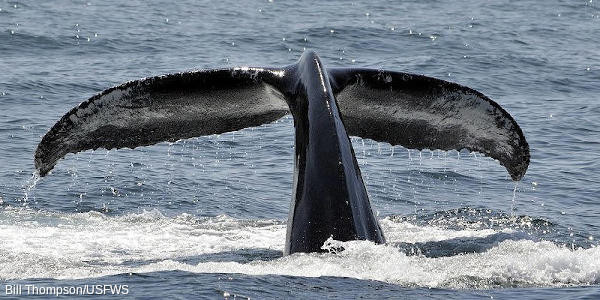 Humpback whale diving its tail above the water
Humpback whale diving its tail above the water
Imagine: “Whales, famously, talk to one another across entire ocean basins, while dolphins use sound, like bats, for echolocation.”
SIXT.VN can organize trips to some of Vietnam’s most beautiful coastal locations.
4. How Does Sound Energy Travel Through Solids?
Sound energy can also travel through solids, such as metal, wood, and glass. The speed of sound varies depending on the density and elasticity of the material. Generally, sound travels faster in denser and more elastic materials.
5. What Factors Affect How Sound Energy Travels?
Several factors can affect how sound energy travels, including:
- Medium: Sound travels fastest in solids, followed by liquids, and slowest in gases.
- Temperature: Sound travels faster in warmer mediums.
- Density: Sound travels faster in denser mediums.
- Humidity: Humidity affects the density of air, influencing sound travel.
Vietnam’s diverse climate, from the humid Mekong Delta to the cooler highlands, can influence how sound travels.
6. How Do We Hear Sound Energy?
We hear sound energy when sound waves enter our ears and cause our eardrums to vibrate. These vibrations are then transmitted through the tiny bones in our middle ear to the cochlea, a fluid-filled structure in the inner ear. The cochlea converts the vibrations into electrical signals, which are sent to the brain for interpretation.
7. What are the Properties of Sound Energy?
The main properties of sound energy are:
- Frequency: The number of sound waves that pass a point in one second, measured in Hertz (Hz). Frequency determines the pitch of a sound.
- Amplitude: The height of a sound wave, which determines the loudness of a sound, measured in decibels (dB).
- Wavelength: The distance between two consecutive peaks or troughs of a sound wave.
- Speed: The rate at which sound travels through a medium, measured in meters per second (m/s).
8. How is Sound Energy Used in Technology?
Sound energy is used in various technologies, including:
- Sonar: Used by submarines and ships to detect objects underwater.
- Ultrasound: Used in medical imaging and therapy.
- Acoustic sensors: Used in microphones, speakers, and other audio equipment.
- Musical instruments: Produce sound waves for entertainment and artistic expression.
9. What is the Speed of Sound and How Does It Vary?
The speed of sound is the distance sound travels through a medium in a given amount of time. It varies depending on the medium and its temperature. The speed of sound in dry air at 20°C (68°F) is approximately 343 meters per second (1,129 feet per second).
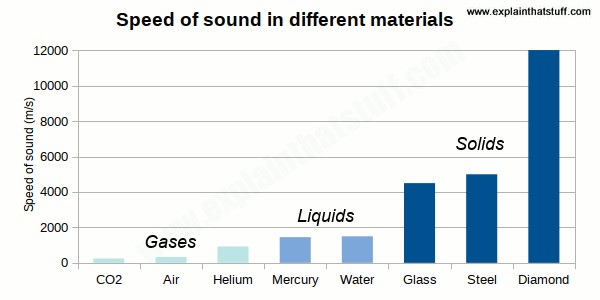 Bar chart showing how the speed of sound compares in common solids, liquids, and gases
Bar chart showing how the speed of sound compares in common solids, liquids, and gases
10. Can Sound Energy Travel Through a Vacuum?
No, sound energy cannot travel through a vacuum. Sound waves require a medium, such as air, water, or solids, to propagate. In a vacuum, there are no particles to vibrate, so sound waves cannot travel.
Remember Robert Boyle’s classic experiment?
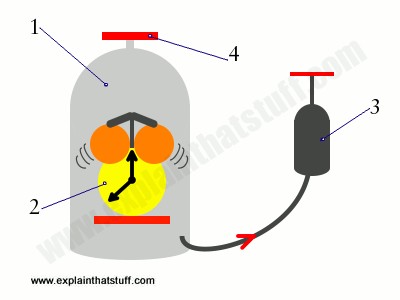 Robert Boyle
Robert Boyle
“As the air gradually disappeared, the sound died out because there was nothing left in the jar for it to travel through.”
11. What is Sound Intensity and How is it Measured?
Sound intensity is the amount of sound energy that passes through a unit area in a unit of time. It is measured in watts per square meter (W/m²). Sound intensity is related to the amplitude of the sound wave. The higher the amplitude, the greater the sound intensity.
12. How Does Temperature Affect the Speed of Sound?
Temperature affects the speed of sound because it changes the kinetic energy of the molecules in the medium. In warmer mediums, the molecules move faster and collide more frequently, which allows sound waves to propagate more quickly.
13. What Are Longitudinal and Transverse Waves in Relation to Sound?
Sound waves are longitudinal waves, meaning that the particles of the medium vibrate parallel to the direction of wave propagation. In contrast, transverse waves, such as light waves, vibrate perpendicular to the direction of wave propagation.
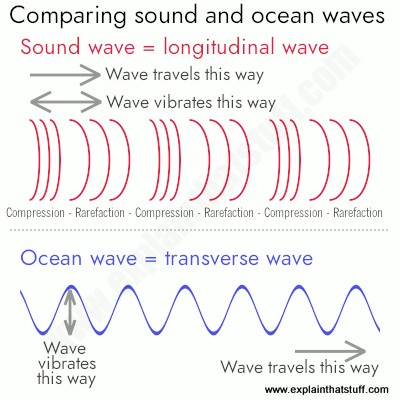 A line artwork comparing longitudinal sound waves and transverse ocean waves.
A line artwork comparing longitudinal sound waves and transverse ocean waves.
14. What is Reverberation and How Does It Affect Sound Quality?
Reverberation is the persistence of sound in a space after the original sound source has stopped. It is caused by sound waves reflecting off surfaces in the space. Reverberation can enhance the sound quality in some cases, such as in concert halls, but it can also degrade sound quality in other cases, such as in small, enclosed rooms.
15. How Can Sound Energy be Absorbed or Reflected?
Sound energy can be absorbed by materials that convert sound energy into other forms of energy, such as heat. Soft, porous materials, such as carpets and curtains, are good sound absorbers. Sound energy can be reflected by hard, smooth surfaces, such as walls and ceilings.
16. What is the Doppler Effect and How Does It Relate to Sound?
The Doppler effect is the change in frequency of a sound wave when the source of the sound or the observer is moving. When the source of the sound is moving towards the observer, the frequency increases, and the sound is perceived as higher pitched. When the source of the sound is moving away from the observer, the frequency decreases, and the sound is perceived as lower pitched.
17. How Do Musical Instruments Produce Sound Energy?
Musical instruments produce sound energy by causing a part of the instrument to vibrate. The vibrations create sound waves, which travel through the air and are heard as music. Different instruments produce different sounds depending on the size, shape, and material of the vibrating part.
Photo: “Musical sound is arguably humankind’s greatest invention.”
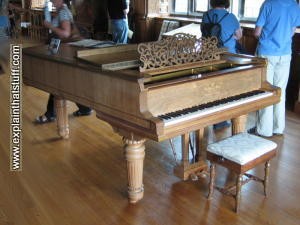 A Steinway grand piano at Lanhydrock, Cornwall
A Steinway grand piano at Lanhydrock, Cornwall
18. What Are Harmonics and How Do They Affect Sound Quality?
Harmonics are frequencies that are multiples of the fundamental frequency of a sound. They are also called overtones. Harmonics contribute to the timbre, or sound quality, of a sound. Different instruments produce different patterns of harmonics, which is why they sound different from each other.
19. How Does Sound Energy Relate to Acoustics?
Acoustics is the science of sound. It deals with the production, transmission, and reception of sound. Acoustics is used to design concert halls, recording studios, and other spaces to optimize sound quality.
20. What is Noise Pollution and How Does It Affect Our Health?
Noise pollution is unwanted or excessive sound that can have harmful effects on human health and the environment. Exposure to noise pollution can cause hearing loss, sleep disturbances, stress, and other health problems.
21. How Do Echolocation and Sonar Use Sound Energy?
Echolocation and sonar use sound energy to detect objects by emitting sound waves and analyzing the echoes that return. Bats use echolocation to navigate and find food in the dark. Submarines use sonar to detect other vessels and objects underwater.
22. What is Ultrasound and How is it Used in Medicine?
Ultrasound is sound with a frequency higher than the upper limit of human hearing (typically 20 kHz). It is used in medical imaging to visualize internal organs and tissues. Ultrasound is also used in therapeutic applications, such as breaking up kidney stones and delivering drugs to specific locations in the body.
23. How Does Sound Energy Contribute to Communication?
Sound energy is essential for communication. We use sound to speak, listen, and understand each other. Sound is also used in music, which is a powerful means of expressing emotions and ideas.
24. What is Sound Masking and How is it Used?
Sound masking is the process of adding background sound to reduce the audibility of unwanted sounds. It is used in offices, hospitals, and other environments to improve privacy and reduce distractions.
25. How is Sound Energy Used in Architectural Design?
Sound energy is an important consideration in architectural design. Architects use acoustic principles to design spaces that are comfortable and functional for their intended use. They consider factors such as reverberation, sound absorption, and noise isolation.
26. What are the Applications of Sound Energy in Environmental Monitoring?
Sound energy is used in environmental monitoring to detect and track animals, monitor noise levels, and study underwater ecosystems. Acoustic sensors can be used to identify different species of animals by their calls and songs.
27. How Does Sound Energy Play a Role in Seismic Exploration?
Seismic exploration uses sound energy to map underground geological structures. Sound waves are generated on the surface of the Earth, and the echoes that return are analyzed to create images of the subsurface. This technique is used to find oil, gas, and other natural resources.
28. What is Acoustic Levitation and How Does It Work?
Acoustic levitation is the use of sound waves to suspend objects in the air. It works by creating a standing wave with points of high and low pressure. Objects can be trapped at the points of low pressure, where the force of gravity is balanced by the force of the sound waves.
29. How is Sound Energy Used in Industrial Applications?
Sound energy is used in various industrial applications, such as ultrasonic cleaning, welding, and testing. Ultrasonic cleaning uses high-frequency sound waves to remove dirt and contaminants from surfaces. Ultrasonic welding uses sound waves to join materials together. Ultrasonic testing uses sound waves to detect flaws in materials.
30. What Future Innovations Can We Expect in Sound Energy Technology?
Future innovations in sound energy technology may include:
- More efficient and powerful ultrasonic devices
- Advanced acoustic sensors for environmental monitoring
- New techniques for sound masking and noise control
- Innovative applications of acoustic levitation
31. What Are Some Common Misconceptions About Sound Energy?
-
Misconception: Sound travels faster in a louder environment.
- Fact: A loud sound or a soft sound, a high-pitched sound or a low-pitched one doesn’t actually make any difference to its speed: the amplitude and frequency don’t matter.
-
Misconception: You cannot hear sound in space.
- Fact: Sound cannot travel in space due to the vacuum, but if you were in a spaceship, sound could travel as the waves vibrate along the metal.
32. How Can You Demonstrate the Properties of Sound Energy at Home?
You can demonstrate the properties of sound energy at home with simple experiments:
- Rubber Band Guitar: Stretch a rubber band around a box and pluck it to create sound. Change the tension to alter the pitch.
- Tuning Fork in Water: Strike a tuning fork and touch it to the surface of water to see the vibrations create ripples.
- Clap Echo Method: Measure the speed of sound by clapping and listening for the echo.
Artwork: Measuring the speed of sound by the clap-echo method.
33. What are the Ethical Considerations in Using Sound Energy?
Ethical considerations in using sound energy include:
- Minimizing noise pollution
- Protecting marine animals from harmful sonar
- Ensuring the responsible use of ultrasound in medicine
34. How Can I Learn More About Sound Energy?
You can learn more about sound energy through:
- Science books and articles
- Online resources and educational websites
- Museum exhibits and science centers
35. How Can SIXT.VN Enhance My Travel Experience in Vietnam?
SIXT.VN simplifies your Vietnamese adventure, from arrival to departure. We offer:
- Airport Transfers: Start your journey stress-free with our reliable airport transfer service.
- Hotel Booking: Choose from a curated selection of hotels that fits your budget and preferences.
- Tours: Immerse yourself in Vietnam’s culture with our expertly crafted tours.
- Flight Booking: Let us handle your flight arrangements for a seamless travel experience.
36. What Types of Accommodation Can I Book Through SIXT.VN?
Through SIXT.VN, you can discover a wide range of accommodation options.
37. How Can I Book Tours and Activities in Vietnam Through SIXT.VN?
To book tours, here are some examples of what you can find in Hanoi.
38. What is the Best Way to Get Around Vietnam Using SIXT.VN?
SIXT.VN offers reliable and comfortable transportation options throughout Vietnam:
- Private Car Service: Hire a private car with a driver for flexible and convenient travel.
- Motorbike Rentals: Explore Vietnam’s scenic routes at your own pace.
- Airport Transfer: SIXT.VN assures you that you can book airport transfers to various locations.
39. What Are Some Tips for Planning a Sustainable Trip to Vietnam with SIXT.VN?
SIXT.VN supports sustainable tourism:
- Eco-Friendly Hotels: Choose accommodations committed to environmental sustainability.
- Responsible Tours: Select tours that respect local cultures and ecosystems.
- Reduce Waste: Minimize your environmental impact by reducing waste and using reusable items.
40. What are the Key Cultural Experiences I Shouldn’t Miss in Vietnam, and How Can SIXT.VN Help Me Access Them?
Vietnam is rich in culture, and here are some experiences.
41. What Are Some Practical Tips for First-Time Visitors to Vietnam That SIXT.VN Can Help With?
SIXT.VN ensures a smooth trip to Vietnam for first timers.
42. How Can SIXT.VN Assist With Visa Requirements and Other Travel Documents for Vietnam?
Ensure a smooth visa process with SIXT.VN’s support:
- Visa Information: Receive up-to-date information on visa requirements.
- Document Checklist: Get a comprehensive checklist of necessary travel documents.
- Assistance with Applications: Get professional assistance to ensure compliance.
43. How Does SIXT.VN Ensure Customer Safety and Support During Travel in Vietnam?
SIXT.VN provides safety and support:
- 24/7 Customer Service: Rely on our round-the-clock support for any issues.
- Local Partnerships: We have trusted partnerships with local businesses for reliable service.
- Safety Standards: We ensure all services meet high safety standards.
44. What are the Benefits of Booking My Vietnam Trip Through SIXT.VN Compared to Other Platforms?
SIXT.VN is your trusted partner for exploring Vietnam. We provide personalized service, local expertise, and reliable support to ensure your trip is seamless and unforgettable.
45. How Can I Contact SIXT.VN for Personalized Travel Advice and Booking Assistance?
Ready to plan your Vietnamese adventure? Contact SIXT.VN today:
- Address: 260 Cau Giay, Hanoi, Vietnam
- Hotline/WhatsApp: +84 986 244 358
- Website: SIXT.VN
46. What Are the Best Times of Year to Visit Vietnam for Specific Activities, and How Can SIXT.VN Accommodate These Plans?
Vietnam’s seasons offer unique experiences.
47. How Can SIXT.VN Help Me Find Unique and Off-the-Beaten-Path Experiences in Vietnam?
SIXT.VN gives you unique and unexplored tours in Vietnam:
- Custom Tours: Create personalized itineraries tailored to your interests.
- Local Guides: We have experts that lead you into undiscovered hidden treasures.
- Hidden Gems: We will recommend and take you to exclusive locations.
48. What Payment Options are Available When Booking Services with SIXT.VN?
SIXT.VN offers flexible payment options:
- Credit/Debit Cards: Pay securely with major credit and debit cards.
- Bank Transfers: Process payments directly from your bank account.
- Online Payment Gateways: Use popular online payment platforms for convenience.
49. How Does SIXT.VN Handle Cancellations and Refunds if My Travel Plans Change?
SIXT.VN has a transparent cancellation and refund policy:
- Flexible Policies: We are open for accommodations based on changes.
- Clear Communication: We make sure that you are informed in a timely manner.
- Refund Processing: We will refund you based on the policies.
50. How Does SIXT.VN Support Local Communities Through Tourism?
SIXT.VN is committed to responsible tourism:
- Supporting Local Businesses: Prioritizing partnerships with local businesses to boost economies.
- Cultural Preservation: Showcasing tours to promote cultural heritage.
- Community Engagement: Contributing to various local activities.
FAQ About Sound Energy and Travel
- What is sound energy?
Sound energy is a form of energy produced by vibrating objects. It travels as waves through a medium and is perceived by our ears as sound. - How Does Sound Energy Travel?
Sound energy travels as longitudinal waves through a medium, such as air, water, or solids. - Does sound energy travel faster in air or water?
Sound energy travels faster in water than in air because water is denser than air. - Can sound energy travel through a vacuum?
No, sound energy cannot travel through a vacuum because it requires a medium to propagate. - What is the speed of sound in air?
The speed of sound in dry air at 20°C (68°F) is approximately 343 meters per second (1,129 feet per second). - How does temperature affect the speed of sound?
Sound travels faster in warmer mediums because the molecules move faster and collide more frequently. - What is the relationship between frequency and pitch?
Frequency is the number of sound waves that pass a point in one second, and it determines the pitch of a sound. - What is the relationship between amplitude and loudness?
Amplitude is the height of a sound wave, and it determines the loudness of a sound. - What are harmonics?
Harmonics are frequencies that are multiples of the fundamental frequency of a sound. - How is sound energy used in technology?
Sound energy is used in various technologies, including sonar, ultrasound, acoustic sensors, and musical instruments.
Ready to explore Vietnam with the peace of mind that comes with expert planning and support? Contact SIXT.VN today and let us craft your dream itinerary!
Address: 260 Cau Giay, Hanoi, Vietnam. Hotline/Whatsapp: +84 986 244 358. Website: SIXT.VN.



